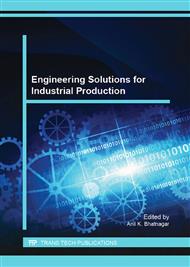[1]
Maydanik, Y. F., Vershinin S V., Kholodov V. F., and Dolgirev J E., Heat Transfer Apparatus, United States Patent, No. 4515209, (1985).
Google Scholar
[2]
Maydanik Y F., Pastukhov V G., Loop Heat Pipes – Recent Developments, Test Results and Applications, SAE paper, 1999-01-2530.
DOI: 10.4271/1999-01-2530
Google Scholar
[3]
Dickey J T., and Peterson G P., Experimental and Analytical Investigation of a Capillary Pumped Loop, Journal of Thermophysics and Heat Transfer, Vol. 8, No. 3, pp.602-607, (1994).
DOI: 10.2514/3.584
Google Scholar
[4]
Hoang T T., O'Connell T., Ku J., Butler D., Swanson T., Miniature Loop Heat Pipes for Electronic Cooling, International Electronic Packaging Technical Conference, Hawaii, USA, July, (2003).
DOI: 10.1115/ipack2003-35245
Google Scholar
[5]
Boo J H., Chung W B., Thermal Performance of a Small-Scale Loop Heat Pipe with PP Wick, 13th International Heat Pipe Conference, Shanghai, China, September, pp.21-25, (2004).
Google Scholar
[6]
Nishikawara M., Nagano H., Kaya T., Transient Thermo-Fluid Modeling of Loop Heat Pipes and Experimental Validation, Journal of Thermophysics and Heat Transfer, Vol. 27, No. 4, p.641–647, (2013).
DOI: 10.2514/1.t3888
Google Scholar
[7]
Nishikawara M., Nagano H., Parametric experiments on a miniature loop heat pipe with PTFE wicks, Journal of Thermal Sciences, Vol. 85, pp.29-39, (2014).
DOI: 10.1016/j.ijthermalsci.2014.05.016
Google Scholar
[8]
Wu S.C., Gu T.W., Wang D., Chen Y.M., Study of PTFE wick structure applied to loop heat pip, Applied Thermal Engineering, Vol. 81, pp.51-57, (2015).
DOI: 10.1016/j.applthermaleng.2015.01.048
Google Scholar
[9]
Wu S.C., Lo K.C., Chen J.R., Chung C.Y., Lin W.J., Su S.J., Effect of Sintering Temperature Curve in Wick Manufactured for Loop Heat Pipe with Flat Evaporator, Applied Mechanics & Materials, Vol. 595, pp.24-29, (2014).
DOI: 10.4028/www.scientific.net/amm.595.24
Google Scholar
[10]
Lin F.C., Yeh C.C., Wu S.C., Chen Y.M., Mathematical Model of Heat and Mass Transfer in a Wick Structure of a Loop Heat Pipe, IMPACT 4th International Microsystems, Packaging, Assembly and Circuits Technology Conference, Taipei, Taiwan, October, pp.356-359, (2009).
DOI: 10.1109/impact.2009.5382190
Google Scholar


